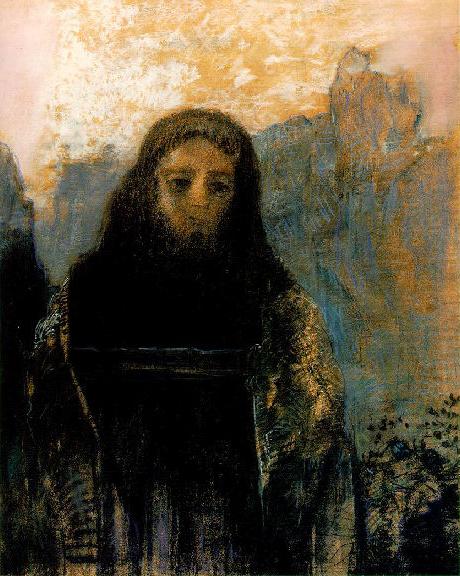
LIFE AS MYTH
![]()
JOURNAL
![]()
JOURNAL 2007
![]()
Following a white hart
Exploring myth & meaning
![]()
AUTUMN 2007
Following a white hart
Index 2007A fool, a cup, and a wounded fisher king
St. Brendan and the mermaid at Clonfert
![]()
LIFEWORKS
![]()
ATLAS
![]()

AUTUMN 2007
A FOOL, A CUP AND A WOUNDED FISHER KING
Parsifal alternately known as Saint John. Redon. 1912. Musée D'Orsay. Paris.
One day you finally knew
what you had to do, and began . . .
"The Mary Oliver (b. 1935), American poetWhen Parsifal lost his father, he was still a little boy and so his mother took him to an isolated cottage in the woods to raise him. In this way his mother shielded him from all knowledge of the world and its dangers. One day, however, he encountered a Grail knight and decided that he, too, would become one. A mere fifteen years old and dressed only in the homespun garments his mother made for him, Parsifal left home.
His travels brought him to the magical Grail Castle. Not everyone can see the castle but since Parsifal was innocent and pure he was able to see it. Once inside, he met the wounded Fisher King and witnessed the spectacle of the Grail procession. The Fisher King, as the keeper of the Holy Grail, suffered from an unhealed wound to his leg. His pain was unceasing and, as a result, he was unable to do anything but fish. The wounding of the king had transformed the kingdom into a wasteland.
Parsifal longed to ask what the procession meant and why the king suffered. But his mother had warned him that it was impolite to be inquisitive and so he refrained from asking any questions. This silence was tragic, as asking those questions would have ended the suffering of the king. Shortly after leaving the castle, Parsifal learned of his mistake. He wanted to return and set things right but it was too late. The Grail Castle had disappeared.
For the next twenty years, Parsifal tried to find his way back to the castle and to the wounded Fisher King. Finally he did (after many adventures) and when he asked the questions -- Why does the king suffer? Whom does the Grail serve? -- the Fisher King was healed and Parsifal, no longer a young fool, became the keeper of the Grail.

